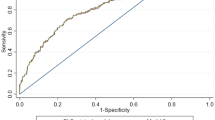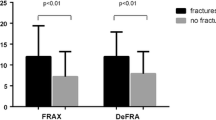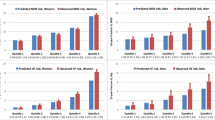Abstract
Summary
A Swiss-specific FRAX® model was developed. Patient profiles at increased probability of fracture beyond currently accepted reimbursement thresholds for bone mineral density (BMD) measurement by dual X-ray absorptiometry (DXA), and osteoporosis treatment were identified.
Introduction
This study aimed to determine which constellations of clinical risk factors, alone, or combined with BMD measurement by DXA, contribute to improved identification of Swiss patients with increased probability of fracture.
Methods
The 10-year probability of hip and any major osteoporotic fracture was computed for both sexes, based on Swiss epidemiological data, integrating fracture risk and death hazard, in relation to validated clinical risk factors, with and without BMD values.
Results
Fracture probability increased with age, lower body mass index (BMI), decreasing BMD T-score, and all clinical risk factors used alone or combined. Several constellations of risk factor profiles were identified, indicating identical or higher absolute fracture probability than risk factors currently accepted for DXA reimbursement in Switzerland. With identical sex, age and BMI, subjects with parental history of hip fracture had as high a probability of any major osteoporotic fracture as patients on oral glucocorticoids or with a prevalent fragility fracture. The presence of additional risk factors further increased fracture probability.
Conclusions
The customised FRAX® model indicates that a shift from the current DXA-based intervention paradigm, toward a fracture risk continuum based on the 10-year probability of any major osteoporotic fracture may improve identification of patients at increased fracture risk.


Similar content being viewed by others
References
Kanis JA, Burlet N, Cooper C et al (2008) European guidance for the diagnosis and management of osteoporosis in postmenopausal women. Osteoporos Int 19:399–428
Lippuner K, Golder M, Greiner R (2005) Epidemiology and direct medical costs of osteoporotic fractures in men and women in Switzerland. Osteoporos Int 16(Suppl 2):S8–S17
Mathers CD, Murray CJL, Lopez AD et al (2001) World Health Organization Global Programme on Evidence for Health Policy Discussion Paper No. 38. http://www.who.int/healthinfo/paper38.pdf. Accessed on May 13, 2006
Robine JM, Paccaud F (2005) Nonagenarians and centenarians in Switzerland, 1860–2001: a demographic analysis. J Epidemiol Community Health 59:31–37
Bundesamt für Statistik. Szenarien zur Bevölkerungsentwicklung der Schweiz 2005-2050. http://www.bfs.admin.ch/bfs/portal/de/index/news/publikationen.Document.83713.pdf. Accessed on May 14, 2008
Schwenkglenks M, Lippuner K, Hauselmann HJ et al (2005) A model of osteoporosis impact in Switzerland 2000–2020. Osteoporos Int 16:659–671
(1993) Consensus development conference: diagnosis, prophylaxis, and treatment of osteoporosis. Am J Med 94:646-650
Kanis JA, Melton LJ 3rd, Christiansen C et al (1994) The diagnosis of osteoporosis. J Bone Miner Res 9:1137–1141
Kanis JA, McCloskey EV, Johansson H et al (2008) A reference standard for the description of osteoporosis. Bone 42:467–475
Kanis JA, Johnell O, Oden A et al (2000) Risk of hip fracture according to the World Health Organization criteria for osteopenia and osteoporosis. Bone 27:585–590
Siris ES, Miller PD, Barrett-Connor E et al (2001) Identification and fracture outcomes of undiagnosed low bone mineral density in postmenopausal women: results from the National Osteoporosis Risk Assessment. Jama 286:2815–2822
Suhm N, Lamy O, Lippuner K (2008) Management of fragility fractures in Switzerland: results of a nationwide survey. Swiss Med Wkly 138:674–683
Kanis JA, Oden A, Johnell O et al (2007) The use of clinical risk factors enhances the performance of BMD in the prediction of hip and osteoporotic fractures in men and women. Osteoporos Int 18:1033–1046
Krieg MA, Cornuz J, Ruffieux C et al (2006) Prediction of hip fracture risk by quantitative ultrasound in more than 7000 Swiss women > or = 70 years of age: comparison of three technologically different bone ultrasound devices in the SEMOF study. J Bone Miner Res 21:1457–1463
Dawson-Hughes B, Tosteson AN, Melton LJ 3rd et al (2008) Implications of absolute fracture risk assessment for osteoporosis practice guidelines in the USA. Osteoporos Int 19:449–458
Fujiwara S, Nakamura T, Orimo H et al (2008) Development and application of a Japanese model of the WHO fracture risk assessment tool (FRAX). Osteoporos Int 19:429–435
Lippuner K, Johansson H, Kanis J et al (2008) Remaining lifetime and absolute 10-year probabilities of osteoporotic fracture in Swiss men and women. Osteoporos Int . doi:10.1007/s00198-008-0779-8
United Nations population division (2003) World population prospects: the 2002 revision and world urban prospects. Population Division of the Dept Economic and Social Affairs of the UN Secretariat
Looker AC, Wahner HW, Dunn WL et al (1998) Updated data on proximal femur bone mineral levels of US adults. Osteoporos Int 8:468–489
Kanis JA, Johnell O, Oden A et al (2008) FRAX and the assessment of fracture probability in men and women from the UK. Osteoporos Int 19:385–397
Kanis JA, Johansson H, Oden A et al (2004) A meta-analysis of prior corticosteroid use and fracture risk. J Bone Miner Res 19:893–899
Melton LJ 3rd, Achenbach SJ, Gebhart JB et al (2007) Influence of hysterectomy on long-term fracture risk. Fertil Steril 88:156–162
Melton LJ 3rd, Khosla S, Malkasian GD et al (2003) Fracture risk after bilateral oophorectomy in elderly women. J Bone Miner Res 18:900–905
Melton LJ 3rd, Alothman KI, Khosla S et al (2003) Fracture risk following bilateral orchiectomy. J Urol 169:1747–1750
Vestergaard P, Mosekilde L (2002) Fracture risk in patients with celiac Disease, Crohn's disease, and ulcerative colitis: a nationwide follow-up study of 16, 416 patients in Denmark. Am J Epidemiol 156:1–10
Vestergaard P, Krogh K, Rejnmark L et al (2000) Fracture risk is increased in Crohn's disease, but not in ulcerative colitis. Gut 46:176–181
Loftus EV Jr, Achenbach SJ, Sandborn WJ et al (2003) Risk of fracture in ulcerative colitis: a population-based study from Olmsted County, Minnesota. Clin Gastroenterol Hepatol 1:465–473
Loftus EV Jr, Crowson CS, Sandborn WJ et al (2002) Long-term fracture risk in patients with Crohn's disease: a population-based study in Olmsted County, Minnesota. Gastroenterology 123:468–475
Zehnder Y, Luthi M, Michel D et al (2004) Long-term changes in bone metabolism, bone mineral density, quantitative ultrasound parameters, and fracture incidence after spinal cord injury: a cross-sectional observational study in 100 paraplegic men. Osteoporos Int 15:180–189
Vestergaard P, Mosekilde L (2003) Hyperthyroidism, bone mineral, and fracture risk–a meta-analysis. Thyroid 13:585–593
Kanis JA (2002) Diagnosis of osteoporosis and assessment of fracture risk. Lancet 359:1929–1936
Marshall D, Johnell O, Wedel H (1996) Meta-analysis of how well measures of bone mineral density predict occurrence of osteoporotic fractures. BMJ 312:1254–1259
Cummings SR, Black D (1995) Bone mass measurements and risk of fracture in Caucasian women: a review of findings from prospective studies. Am J Med 98:24S–28S
Black DM, Cummings SR, Genant HK et al (1992) Axial and appendicular bone density predict fractures in older women. J Bone Miner Res 7:633–638
Schwenkglenks M, Lippuner K (2007) Simulation-based cost-utility analysis of population screening-based alendronate use in Switzerland. Osteoporos Int 18:1481–1491
Cummings SR, Black DM, Thompson DE et al (1998) Effect of alendronate on risk of fracture in women with low bone density but without vertebral fractures: results from the Fracture Intervention Trial. Jama 280:2077–2082
Black DM, Delmas PD, Eastell R et al (2007) Once-yearly zoledronic acid for treatment of postmenopausal osteoporosis. N Engl J Med 356:1809–1822
Black DM, Cummings SR, Karpf DB et al (1996) Randomised trial of effect of alendronate on risk of fracture in women with existing vertebral fractures. Fracture Intervention Trial Research Group. Lancet 348:1535–1541
Neer RM, Arnaud CD, Zanchetta JR et al (2001) Effect of parathyroid hormone (1–34) on fractures and bone mineral density in postmenopausal women with osteoporosis. N Engl J Med 344:1434–1441
Ettinger B, Black DM, Mitlak BH et al (1999) Reduction of vertebral fracture risk in postmenopausal women with osteoporosis treated with raloxifene: results from a 3-year randomized clinical trial. Multiple Outcomes of Raloxifene Evaluation (MORE) Investigators. JAMA 282:637–645
Kanis JA, Johansson H, Oden A et al (2009) Bazedoxifene reduces vertebral and clinical fractures in postmenopausal women at high risk assessed with FRAX®. Bone 44:1049–1054. doi:10.1016/j.bone.2009.02.014
McCloskey EV, Johansson H, Oden A et al (2009) Ten-year fracture probability identifies women who will benefit from clodronate therapy—additional results from a double blind, placebo-controlled randomised study. Osteoporos Int 20:811–817. doi:10.1007/s00198-008-0786-9
Pongchaiyakul C, Nguyen ND, Jones G et al (2005) Asymptomatic vertebral deformity as a major risk factor for subsequent fractures and mortality: a long-term prospective study. J Bone Miner Res 20:1349–1355
Nevitt MC, Ettinger B, Black DM et al (1998) The association of radiographically detected vertebral fractures with back pain and function: a prospective study. Ann Intern Med 128:793–800
Acknowledgements
We are grateful to Dr. Philippe Kress, Kressmed Glattbrugg Switzerland, for his contribution to the writing of the manuscript. Mrs. Marianne Perez and Dr. Sarah Frankland are acknowledged for secretarial assistance and careful reading of the manuscript, respectively.
Funding
This work was supported by an unrestricted research grant from Amgen (Europe), Zug, Switzerland.
Conflicts of interest
None.
Author information
Authors and Affiliations
Corresponding author
Rights and permissions
About this article
Cite this article
Lippuner, K., Johansson, H., Kanis, J.A. et al. FRAX® assessment of osteoporotic fracture probability in Switzerland. Osteoporos Int 21, 381–389 (2010). https://doi.org/10.1007/s00198-009-0975-1
Received:
Revised:
Accepted:
Published:
Issue Date:
DOI: https://doi.org/10.1007/s00198-009-0975-1




